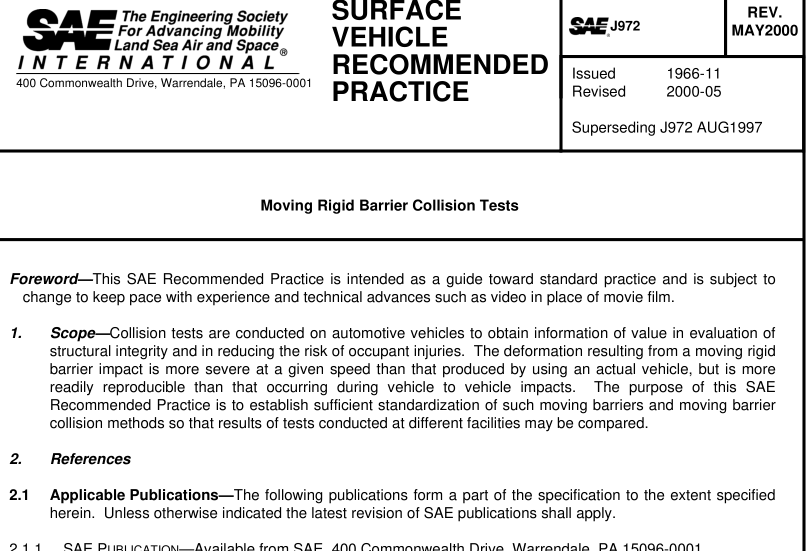SAE J972:2000 pdf download Moving Rigid Barrier Collision Tests
1. Scope—Collision tests are conducted on automotive vehicles to obtain information of value in evaluation of structural integrity and in reducing the risk of occupant injuries. The deformation resulting from a moving rigid barrier impact is more severe at a given speed than that produced by using an actual vehicle, but is more readily reproducible than that occurring during vehicle to vehicle impacts. The purpose of this SAE Recommended Practice is to establish sufficient standardization of such moving barriers and moving barrier collision methods so that results of tests conducted at different facilities may be compared.
2. References
2.1 Applicable Publications—The following publications form a part of the specification to the extent specified herein. Unless otherwise indicated the latest revision of SAE publications shall apply.
2.1 .1 SAE P UBLICATION —Available from SAE, 400 Commonwealth Drive, Warrendale, PA 1 5096-0001 .
SAE J21 1 -1 —Instrumentation for Impact Tests—Part 1 : Electronic Instrumentation SAE J21 1 -2—Instrumentation for Impact Tests—Part 1 : Photographic Instrumentation
2.1 .2 FMVSS P UBLICATION —Available from the Superintendent of Documents, U. S. Government Printing Office, Mail Stop: SSOP, Washington, DC 20402-9320. FMVSS 301 3. Objectives—The primary objective of this document is to define test procedures for impacts which will result in a simulation of forces and deformations experienced during a vehicle crash. Standardized procedures allow evaluation of vehicle structural loads and deflections, occupant loads and dynamics, photographic, video, and post-collision observations of pertinent areas or events which are useful in establishing design criteria.
4. Crash Test Facility
4.1 Test Site, General—The test site shall be of sufficient area to provide accommodations for the test vehicle, various photographic equipment, a protected observer area, and provisions for accelerating the moving barrier to the desired velocity.
4.1 .1 The immediate crash site shall be level.
4.1 .2 The approach road and the surface at the immediate crash site shall be paved.
4.1 .3 Allowances for proper positioning of photographic equipment should be made.
4.1 .4 Allowances should be made for post impact motion of both the test vehicle and the moving barrier.
4.1 .5 Document guide rail and/or steering inputs and location and direction of application
4.2 Approach—The type of approach required depends upon the technique employed to obtain the desired impact velocity of the moving barrier. A practical approach is level, straight, and of sufficient length to permit the moving barrier to be towed along a rail guidance system with the impacts occurring after the moving barrier is released from the tow force and released from guidance at the end of the rail.
4.3 Barrier—Two rigid impact surfaces are used: the flat surface described in 4.3.2 for rear and side impact tests and the contoured surface described in 4.3.3, generally used for school bus testing. These two surfaces are attachable to the front end of a common carriage as shown in Figure 1 .
SAE J972:2000 pdf download
